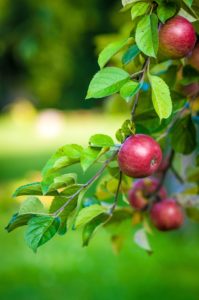
Global Warming or Climate Chaos? Coping with Climate Change
Change in weather patterns has had the counter-intuitive effect of increasing frost damage. Research shows that New York’s apple crops now flower several weeks earlier than their historic norm, making them more vulnerable to late frosts.
By Thomas Christopher
“Global warming” is the popular name for the often dramatic and destructive weather trends that we have been witnessing in our gardens in recent years. My wife the climate researcher, however, prefers to call it “climate chaos.” That’s because what we have seen in the Northeast has not just been a gradual increase in temperatures, but rather an overthrow of the familiar norms.
I was reminded of this recently when I had occasion to speak to Dr. David Wolfe of Cornell University. Dr. Wolfe is a professor of plant and soil ecology who has pursued a special interest in maintaining sustainable gardens in a time of climate change. He is internationally recognized for his expertise in this subject; in 2017, he was invited to speak about it to Britain’s Royal Horticultural Society.
When I spoke to Dr. Wolfe, he pointed out that the effects of climate change will vary widely depending on the area of the United States in which you garden. In the West, for example, the most pronounced effect on gardens is predicted to be a combination of greater summer heat, with accompanying heat stress and drought. Similar changes will afflict the Northeastern gardeners. Climate models predict that total annual precipitation will probably remain about the same, but because plants will need more water to cope with the greater summer heat, they will effectively experience more drought. This will probably be exacerbated by a trend, already beginning, toward fewer and more violent rainstorms. In other words, periods of too little water will probably alternate with periods of too much.
One way to cope with a cycle of this sort, Dr. Wolfe suggested, is to boost the organic content of the soil. By adding copious amounts of compost, for example, the gardener can enhance both the soil’s ability to absorb and retain water, and also make it more porous, so that excess water drains away more promptly. In addition, to conserve the existing organic content of the soil, the gardener should avoid unnecessary digging and tillage. That’s because turning the soil over mixes air into it, which in turn accelerates the breakdown of the soil’s organic portion, and its escape into the atmosphere as carbon dioxide, the principal greenhouse gas that is driving global warming.
Rising temperatures mean that winters will be warmer on average. This could be an opportunity, Dr. Wolfe noted, for gardeners to experiment with less winter hardy plants, plants which may also be adapted to warmer summers. This change in weather patterns has also had the counter-intuitive effect of increasing frost damage. Dr. Wolfe explained that because New York’s apple and grape crops had flowered several weeks earlier than their historic norm in some recent years, they became more vulnerable to late frosts. The same effect translates to spring-blooming garden plants, which are likely to bloom earlier, coming out of dormancy at a time when they are likely to be damaged by late frosts.
Warmer winters are also allowing southern pests and weeds to migrate north. Insects such as the hemlock woolly adelgid which were formerly barred from our region by winters cold are making inroads here, killing the hemlocks in our forests. Even more familiar, long-established insect pests are affected by global warming. Longer summers mean more time for reproduction, with some pests adding more generations and more population growth per year.
Dr. Wolfe recommended enhancing the diversity of the garden, not only by trying new plants but also by varying planting dates to take advantage of and guard against earlier springs and late frosts. One further recommendation is to reduce the amount of greenhouse gases your garden generates. Besides reducing tillage, conscientious gardeners will also reduce their use of synthetic fertilizers, which consume large amounts of fossil fuels in their manufacture. Organic fertilizers are preferable in this respect since they largely consist of agricultural byproducts. Even these should be applied judiciously, however, because nitrates, a common ingredient of most fertilizers, can escape into the atmosphere as nitrous oxide, a greenhouse gas more than 200 times as potent as carbon dioxide.
Thomas Christopher is the co-author of “Garden Revolution” (Timber Press, 2016) and is a volunteer at Berkshire Botanical Garden. berkshirebotanical.org
Be-a-Better-Gardener is a community service of Berkshire Botanical Garden, one of the nation’s oldest botanical gardens in Stockbridge, MA. Its mission to provide knowledge of gardening and the environment through 25 display gardens and a diverse range of classes informs and inspires thousands of students and visitors on horticultural topics every year. Thomas Christopher is the co-author of Garden Revolution (Timber press, 2016) and is a volunteer at Berkshire Botanical Garden. berkshirebotanical.org.



